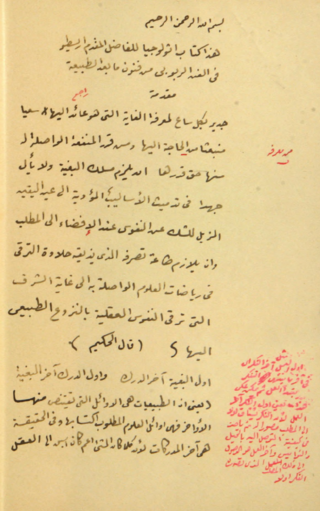The Auctoritates Aristotelis ("Authoritative [passages of] Aristotle") was a popular florilegium (anthology of brief extracts) probably composed around the end of the thirteenth century. In the manuscripts, it was entitled Parvi flores (little flowers), but, when it was printed in the las years of the fifteenth century and in the first quarter of the sixteenth, the title became Auctoritates Aristotelis, Senecae, Boethii, Platonis, Appulei, Empedoclis, Porphyrii et Gilberti Porretani or, for some Italian editions, Propositiones universales Aristotelis et aliorum philosophorum. [1]
This large collection of sententiae (opinions) derived from scholastic texts was compiled around 1300.
In 1974, Jacqueline Hamesse proposed, "in the absence of other information", to consider Marsilius of Padua as the most probable author of the collection, [2] but by 1994, she had come to the conclusion that the author was Johannes de Fonte, a Franciscan and lector in theology at the Franciscan convent in Montpellier. [3]
Johannes de Fonte says in the prologue that his work is intended to provide assistance “as much for preaching to the people as study of the arts.” The work enjoyed a wide circulation, providing a convenient way to access Aristotle's philosophy, or to embellish a composition or sermon with quotations from his work.
The Auctoritates Aristotelis are of great importance in the formation of the first act of the Spanish novel in dialogues La Celestina. [4]

Georges Prosper Remi, known by the pen name Hergé, from the French pronunciation of his reversed initials RG, was a Belgian comic strip artist. He is best known for creating The Adventures of Tintin, the series of comic albums which are considered one of the most popular European comics of the 20th century. He was also responsible for two other well-known series, Quick & Flupke (1930–1940) and The Adventures of Jo, Zette and Jocko (1936–1957). His works were executed in his distinctive ligne claire drawing style.

The Catholic University of Leuven or Louvain was founded in 1834 in Mechelen as the Catholic University of Belgium, and moved its seat to the town of Leuven in 1835, changing its name to Catholic University of Leuven. In 1968, it was split into two universities, the Katholieke Universiteit Leuven and the Université catholique de Louvain, following tensions between the Dutch and French-speaking student bodies.
Landscape archaeology, previously known as total archaeology is a sub-discipline of archaeology and archaeological theory. It studies the ways in which people in the past constructed and used the environment around them. It is also known as archaeogeography. Landscape archaeology is inherently multidisciplinary in its approach to the study of culture, and is used by pre-historical, classic, and historic archaeologists. The key feature that distinguishes landscape archaeology from other archaeological approaches to sites is that there is an explicit emphasis on the sites' relationships between material culture, human alteration of land/cultural modifications to landscape, and the natural environment. The study of landscape archaeology has evolved to include how landscapes were used to create and reinforce social inequality and to announce one's social status to the community at large. The field includes with the dynamics of geohistorical objects, such as roads, walls, boundaries, trees, and land divisions.

Simha Arom is a French-Israeli ethnomusicologist who is recognized as a world expert on the music of central Africa, especially that of the Central African Republic. His books include African Polyphony and Polyrhythm: Musical Structure and Methodology (1991) ISBN 0-521-24160-X. He also made some historical field recordings of the Aka Pygmy music.

Deus vult is a Christian motto relating to Divine providence. It was first chanted by Catholics during the First Crusade in 1096 as a rallying cry, most likely under the form Deus le veult or Deus lo vult, as reported by the Gesta Francorum and the Historia Belli Sacri.

Integral nationalism is a type of nationalism that originated in 19th-century France, was theorized by Charles Maurras and mainly expressed in the ultra-royalist circles of the Action Française. The doctrine is also called Maurrassisme.

The Theology of Aristotle, also called Theologia Aristotelis is a paraphrase in Arabic of parts of Plotinus' Six Enneads along with Porphyry's commentary. It was traditionally attributed to Aristotle, but as this attribution is certainly untrue it is conventional to describe the author as "Pseudo-Aristotle". It had a significant effect on early Islamic philosophy, due to Islamic interest in Aristotle. Al-Kindi (Alkindus) and Avicenna, for example, were influenced by Plotinus' works as mediated through the Theology and similar works. The translator attempted to integrate Aristotle's ideas with those of Plotinus — while trying to make Plotinus compatible with Christianity and Islam, thus yielding a unique synthesis.

Theatrum Chemicum is a compendium of early alchemical writings published in six volumes over the course of six decades. The first three volumes were published in 1602, while the final sixth volume was published in its entirety in 1661. Theatrum Chemicum remains the most comprehensive collective work on the subject of alchemy ever published in the Western world.
Per Kværne is a Norwegian tibetologist and historian of religion.

Jacques Lafaye was a French historian who wrote on cultural and religious Spanish and Latin American history. His most popular work is Quetzalcoatl and Guadalupe written in 1974 regarding the formation of the Mexican National Consciousness and includes a prologue by Octavio Paz and is regarded as a keystone for the understanding of the contemporary Mexican culture and is regarded as one of the most comprehensive analyses of the colonial period in Mexico.
Christiane Ziegler, is a French Egyptologist, curator, director emeritus of the Department of Egyptian Antiquities of the Louvre Museum and editorial director of the archaeological mission from the Louvre Museum at Saqqara, Egypt.

Pierre Grégoire (c.1540–1597) was a French jurist and philosopher

CristóbalOudrid y Segura was a Spanish pianist, conductor, and composer. He is noted for his many contributions to the formation and development of the zarzuela genre in Spain during the second half of the 19th century. He was a gifted musician—but with little technical knowledge, which he bragged about to receive more credit from others with relation to his creations. This habit earned him the scathing criticism of people like Antonio Peña y Goñi who, nevertheless, praised the bright, sensual and cheerful ease with which Oudrid used to bring to life the true meaning of the Spanish song.
Franciscus Monachus, was born Frans Smunck in Mechelen in the Duchy of Brabant. His Latinised name, adopted when he matriculated at the University of Louvain, is translated as simply Francis the monk. Franciscus Monachus was identified as the Latinised form of his name, Frans Smunck, in his obituary notice. He is remembered as the cartographer who created the first terrestrial globe in the Low Countries.

Julien Freund was a French philosopher and sociologist. Freund was called an "unsatisfied liberal-conservative" by Pierre-André Taguieff, for introducing France to the ideas of Max Weber. His work as a sociologist and political theorist is a continuation of Carl Schmitt's. Freund, like many people from Alsace, was fluent in German and French. His works have been translated into nearly 20 languages.
Jacqueline Pirenne was a French archaeologist and epigrapher, who studied ancient South Arabia and Ethiopia.
Béatrice Didier is a French literary critic.

Baron Emmanuel van der Linden d'Hooghvorst (1914–1999) was a Belgian writer, spagyric philosopher and alchemist.

Antonio Piñero Sáenz is a Spanish philologist, writer, and historian, specializing in the Judaism before Christianity, the life of Jesus of Nazareth, the founding of Christianity, and language and literature of the New Testament and early Christianity from a scientific perspective. He is especially known in the Spanish-speaking world for the authorship of numerous books and research articles, and for his active outreach efforts.

The Nine Valleys lawsuit or simply Valleys lawsuit was a legal battle between the Nine Valleys of the Asturias de Santillana and the Dukedom of the Infantado. It was initiated in 1544, and a ruling was issued in 1581 in favor of the Nine Valleys. This result was important in the process of the territorial configuration of Cantabria, since it achieved the independence of the valleys, which were constituted in the province of the Nine Valleys in 1589. This was later formed into the province of Cantabria in 1778, and caused the retreat of the manorial domains in the region. The memorial occupies 178 folios.